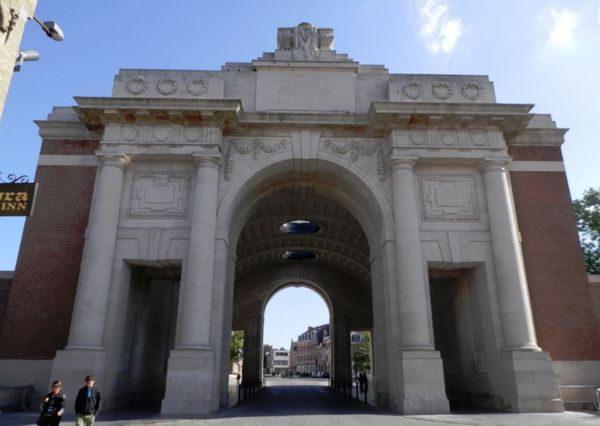Difference between revisions of "George Alexander Armstrong"
From Our Contribution
| Line 46: | Line 46: | ||
| monument3 = [[Armadale and Districts Roll of Honour]] | | monument3 = [[Armadale and Districts Roll of Honour]] | ||
| monumentnote3 = | | monumentnote3 = | ||
| − | | monument4 = | + | | monument4 = [https://www.awm.gov.au/collection/R1727463 Australian War Memorial] |
| monumentnote4 = | | monumentnote4 = | ||
| medal1 = [[British War Medal]] | | medal1 = [[British War Medal]] | ||
Revision as of 01:41, 2 May 2018
 | |
| Personal Information | |
|---|---|
| Date of Birth | Not known |
| Place of Birth | Bethanga, Victoria |
| Death | 4 Oct 1917 |
| Place of Death | Near Passchendaele, Belgium |
| Age at Enlistment | 31 years, 3 months |
| Description |
5' 9" (1.75m) tall ; 153 lbs 69.4 kg ; fair complexion ; blue eyes ; brown hair |
| Occupation | Journalist |
| Religion | Presbyterian |
| Address | NOK 189 Townsend road, Subiaco, Western Australia |
| Next of Kin | Sister , Miss Margaret Elizabeth Armstrong |
| Military Information | |
| Reg Number | 3007 |
| Date of Enlistment | 4 Jan 1916 |
| Rank | Corporal |
| Unit/Formation | 44th Battalion, 7th reinforcement allocated to D Company / 11th Brigade, 4th Division |
| Date of Embarkation | 29 Jan 1917 ‒ 27 Mar 1917 |
| Ship Embarked On | HMAT A28 Miltiades |
| Fate | Killed in Action 4 Oct 1917 during the Battle known as Broodseinde |
| Monument |
Armadale War Memorial (Beenup panel) Menin Gate Memorial Armadale and Districts Roll of Honour https://www.awm.gov.au/collection/R1727463 Australian War Memorial |
| Medals |
British War Medal Victory Medal |
Pre War
Connected with the West Australian paper for about 10 years. Had a good position offered to him by a leading London paper while in the AIF but preferred to be in active service first. After which he felt he would be more competent to write description articles on the war.
War Service
In Blackboy Hill camp he changed unit several times from being a member of the original 44th Battalion, to a reinforcement draft for the 28th Battalion, before spending months in Officers School at Duntroon.
However, due to poor health (asthma) he returned to Perth and was allocated to the 7th reinforcement draft for the 44th Battalion.
On arrival in England he was posted to Tidworth for further training. While there he spent a fortnight in the local Tidworth and Fovant hospitals with tonsillitis. Returning to the 11th Training Battalion, he caught influenza, necessitating a further period in hospital.
Finally, on 19 Jun 1917, George proceeded to France via Southampton and spent a fortnight in Base camp before joining the 44th Battalion on 9 Jul 1917 in the front lines of the Messines Sector. At this time, the front line trenches were full to waist height with mud and water. A week after joining the battalion he was promoted to Temporary Corporal, but in early August, George again sought hospital treatment for a week or so.
In the early morning hours of 4 Oct 1917, the 44th Battalion was one of many launching an attack east of Ypres. Theirs was the second objective of three for the day and they achieved this with only minor losses. The unit war diary reports only minor casualties, and those generally caused by artillery fire so we might assume that is how George was killed. While his records show an entry for "buried", there is no known grave and thus he is listed on the Menin Gate Memorial. His Red Cross file in the Australian War Memorial gives us some additional information.[1]
"I saw him dead, killed I think by a shell as he was badly knocked about. We held the line." 2587 Pte AC Horwood
"He was B Coy signaller. I knew him slightly, I came over in the same reinforcements with him. On the 4th October we had taken Zonnebeke. I saw Armstrong's body on the ground. I didn't see how he was killed. His body was left where it was, the shelling was too heavy to do any burying at the time. 2613 Pte ?.J. Ede
His eldest brother W.C. Armstrong was a Lieutenant with the 28th Battalion.
"George Armstrong, enlisted in December 1915."[2]
[The Drill was often out by a month or so as it appears that hearsay was the basis for their information.]
References
- ↑ https://s3-ap-southeast-2.amazonaws.com/awm-media/collection/RCDIG1035371/document/5535440.PDF accessed 28 Apr 2018
- ↑ "The Drill of the Foot-Hills" (PDF) (1917). Western Australia. Mar 1917. p. 14. Retrieved 16 May 2017 – via State Library of Western Australia..
